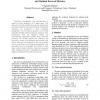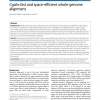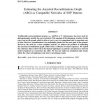192 search results - page 22 / 39 » Genome rearrangements with duplications |
101
click to vote
CSB
2005
IEEE
15 years 5 months ago
2005
IEEE
Traditional phylogenetic tree reconstruction is based on point mutations of a single gene. This approach is hardly suitable for genomes whose genes are almost identical and hardly...
BMCBI
2008
14 years 12 months ago
2008
Background: The number of available genome sequences is increasing, and easy-to-use software that enables efficient comparative analysis is needed. Results: We developed GenomeMat...
BMCBI
2010
14 years 12 months ago
2010
Background: Whole-genome sequence alignment is an essential process for extracting valuable information about the functions, evolution, and peculiarities of genomes under investig...
102
click to vote
JCB
2008
14 years 11 months ago
2008
Traditionally nonrecombinant genome, i.e., mtDNA or Y chromosome, has been used for phylogeography, notably for ease of analysis. The topology of the phylogeny structure in this c...
JCB
2002
14 years 11 months ago
2002
One possible model to study genome evolution is to represent genomes as permutations of genes and compute distances based on the minimum number of certain operations (rearrangemen...



